marqueta.org
You can't always apt-get what you want
Infosec - Cycling - Estudiantes
RHCE / RHCSA
Once a sysadmin, always a sysadmin
Day 3: from Fuente Sidres to El Burgo Ranero
26th May 2024
In the Camino you go to sleep very early and, therefore, you get up very early, with the first pilgrims who like to set off before dawn. I, on the other hand, am not usually in a hurry to leave because, even going slowly, I move at a different pace with the bike.
So I am one of the last to have breakfast and share a table with Chong, a Korean pilgrim.
Maybe it’s a prejudice, or perhaps an unfortunate coincidence, but it seemed to me that many Koreans (and I’ve met a lot on this trip!) chew noisily and don’t hesitate to talk with their mouths full. Certainly, that’s how Chong did it, which made my breakfast quite uncomfortable 😄
The good news is that I could enjoy finally my breakfast: a piece of apple, an omelette, bread, grated tomato, and a black coffee.

Breakfast at Fuente Sidres
Without too much haste, I packed my stuff and placed them on the bike (the girl at the hostel had kindly suggested hosing it down the previous afternoon). I finished my coffee on the porch, enjoying a beautiful sunrise:
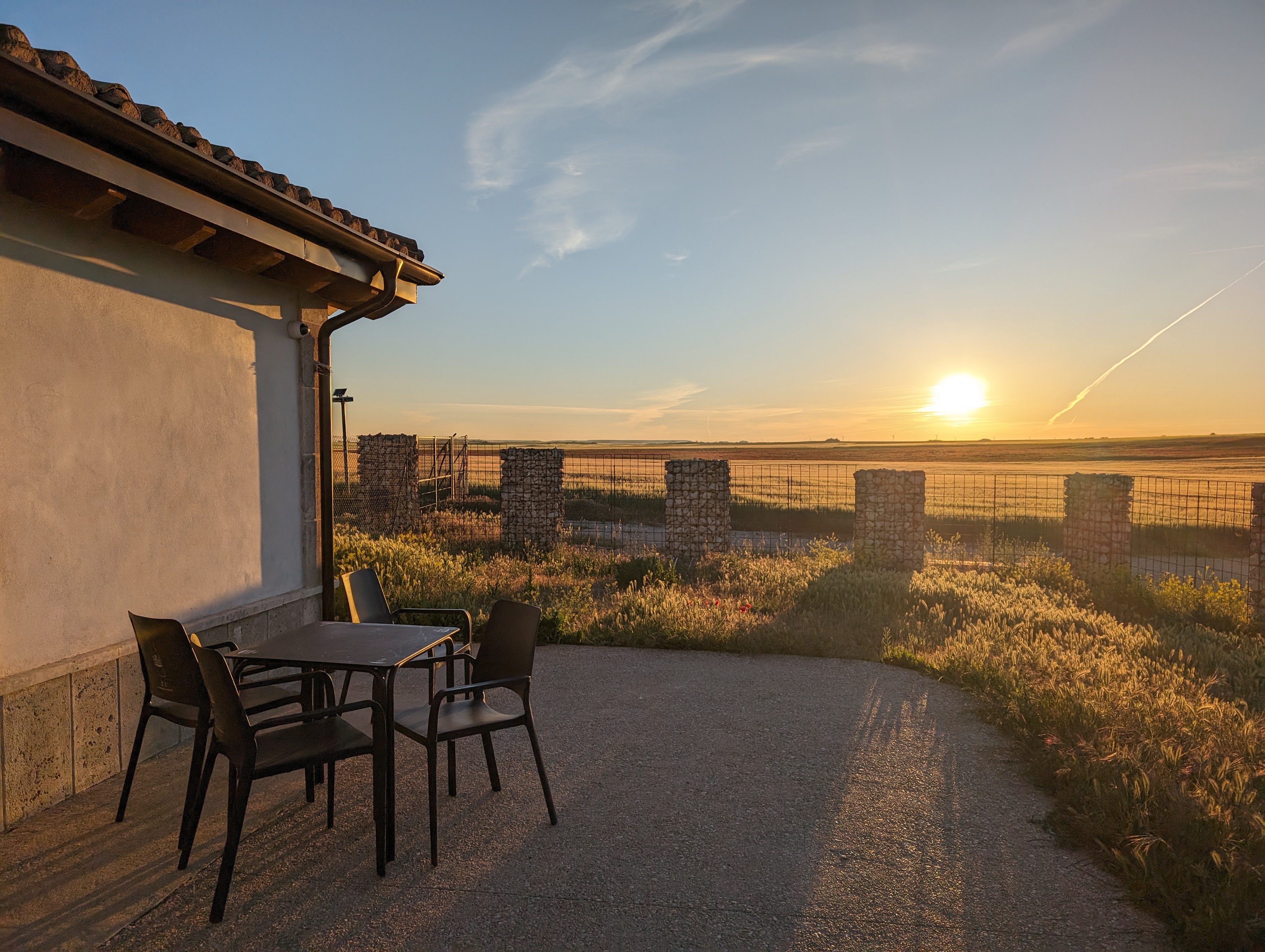
Sunrise at Fuente Sidres
With everything in place, I said goodbye to the couple who run the albergue and set off around 7:45, wearing mywindbreaker jacket since the temperature was below 10°C.
The first kilometers are a moment of extraordinary peace and serenity; the air is clean and fresh, and you can barely hear any noise other than the quiet rolling of my bicycle, as I overtake the first pilgrims who respond with a kind and sincere smile to my “¡Buen Camino!” And there are no smiles like the ones in the Camino, as anyone who has done it knows well…
Soon I left behind the hermitage of Santa Brígida, crossed Hontanas, and took the beautiful and lonely road to Castrojeriz. The terrain is slightly favorable, and despite not going too fast, I feel like the bike is floating, flying…
In just 15 minutes I was under the ruins of the San Antón convent. I stopped to get a stamp and take a look; it hides a small traditional hopitality albergue, without electricity or hot water, where pilgrims are only asked to give what they can.
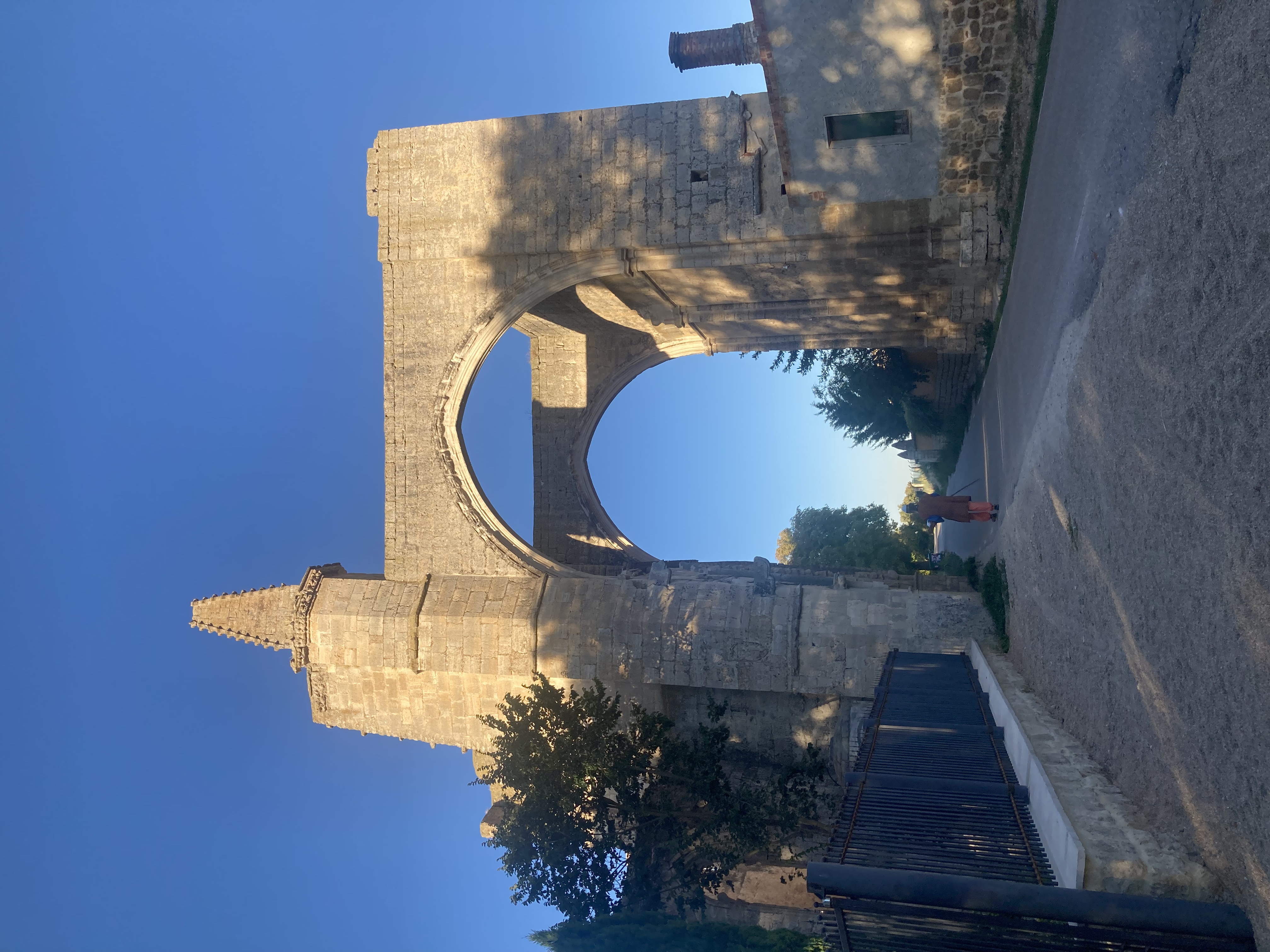
San Antón Convent in 2022
Recently, it had to close because the building remains threaten to collapse, posing a danger not only to pilgrims but to anyone passing under the arch (and the road passes through there). If consolidation works are not carried out and the road is not diverted, it is very likely that it will eventually collapse, losing one of the Camino’s symbols.
I continued to the monumental Castrojeriz, which I crossed heading to the Alto de Mostelares.

Santa María del Manzano (Castrojeriz)
On my previous trip, following the recommendation of a hospitalero, I took a detour by road to Castrillo Mota de Judíos; this time, I ignored that advice and followed the traditional path.
From the exit of Castrojeriz, you can see the tremendous climb of Mostelares. I quickly realized it would not be easy…
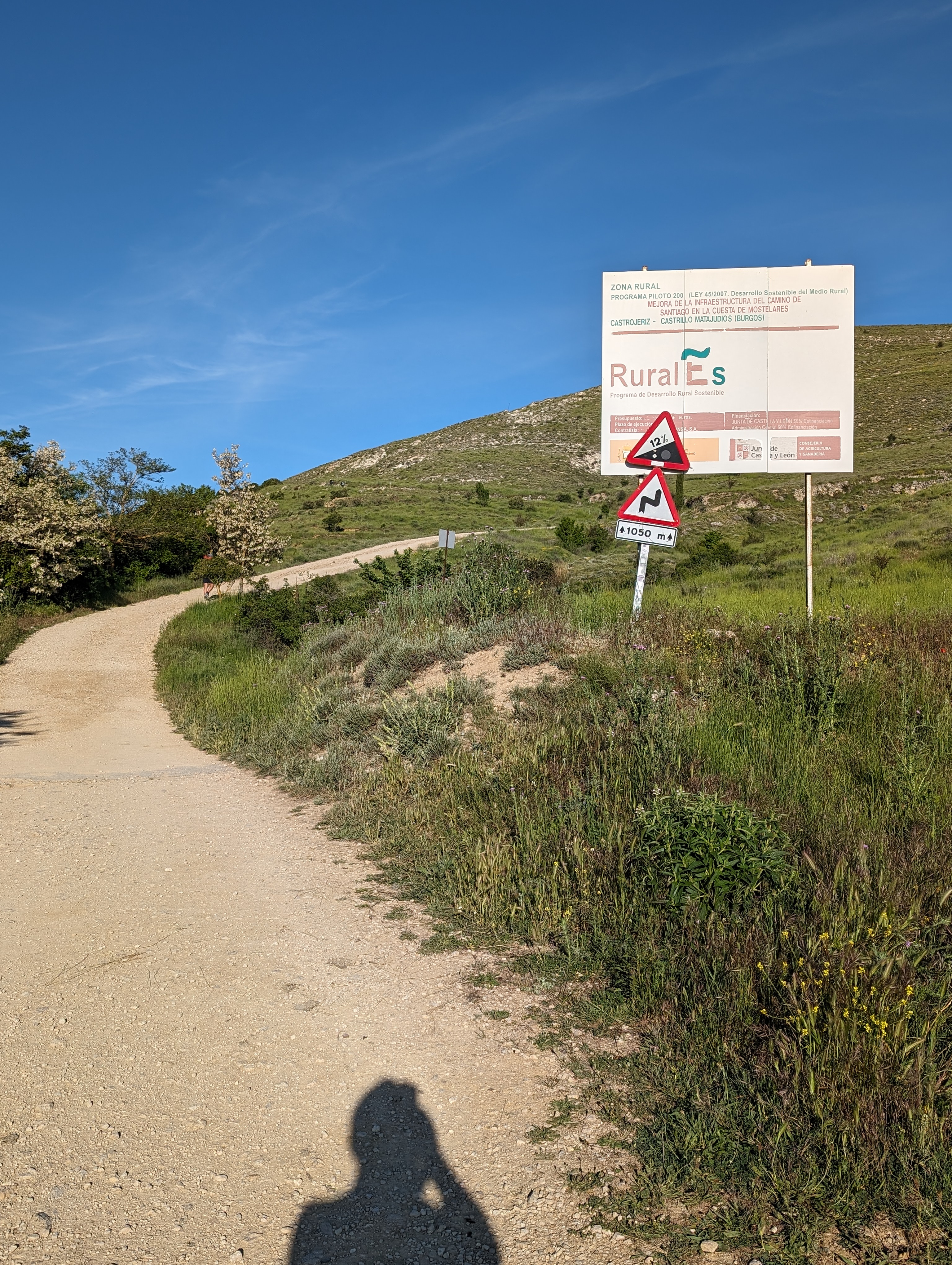
Start of the climb to the Alto de Mostelares
And no, it isn’t. Just after starting the climb, I slipped for the first time and had to get off the bike: it was time to push. The Garmin doesn’t lie:
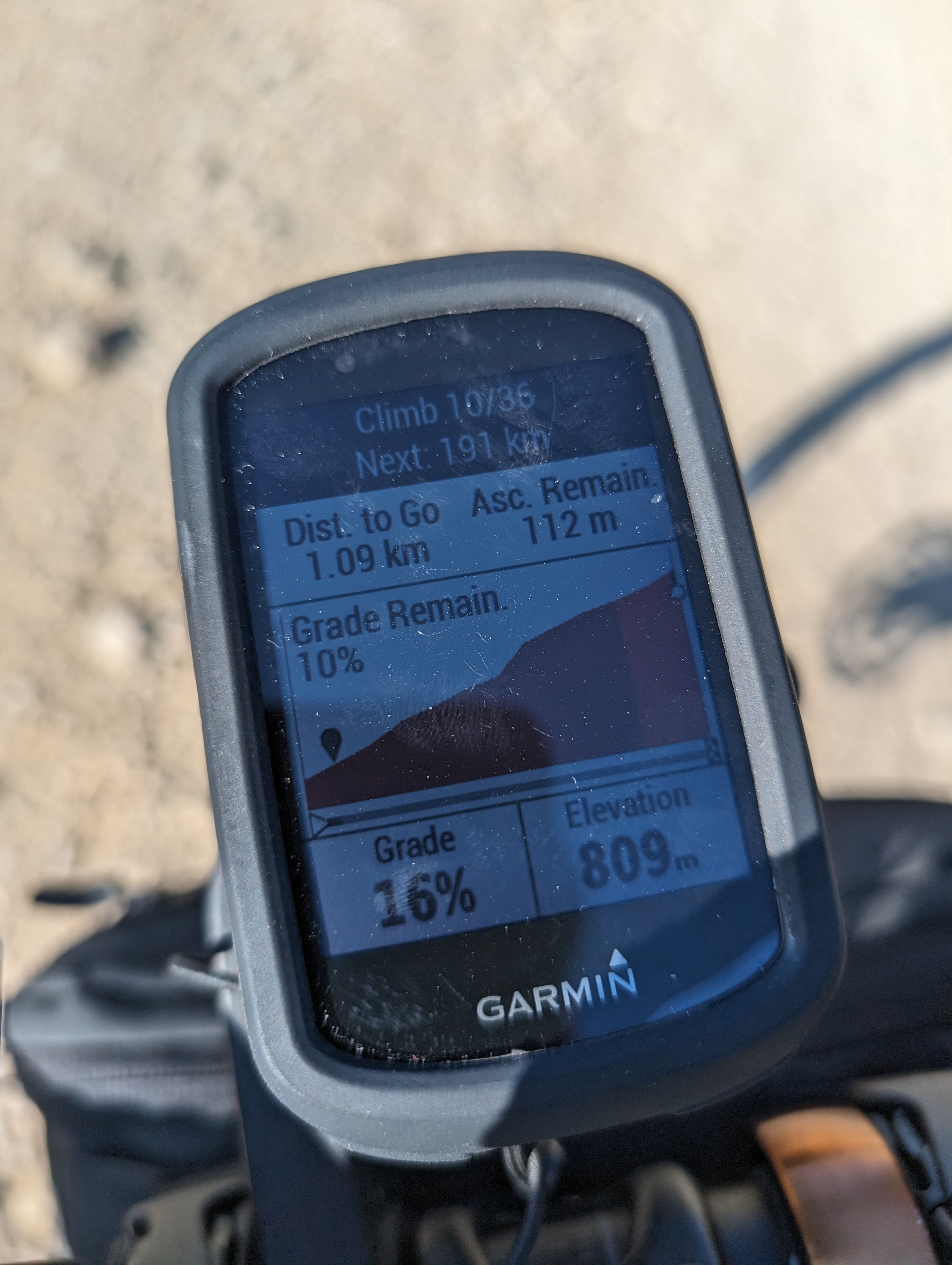
The Alto de Mostelares on the Garmin
Despite pushing the bike, I overtook walking pilgrims because the slope is tough for everyone. Well, almost everyone, because a group of e-bikes passed us cheerfully…
For the last few meters, I gathered a bit of self-respect and got back on the bike. A bit of a silly effort, as I soon stopped to enjoy the scenic views from the top.
After a short break —where I took the opportunity to chat a bit with one of the e-bikers— I moved on a small plateau that led to the start of the descent. A few years ago, it was in very bad condition, but now it is paved, and the descent, although steep (18%), is perfectly manageable by bike. Still, you must be careful not to let the bike go, especially when there are walking pilgrims.
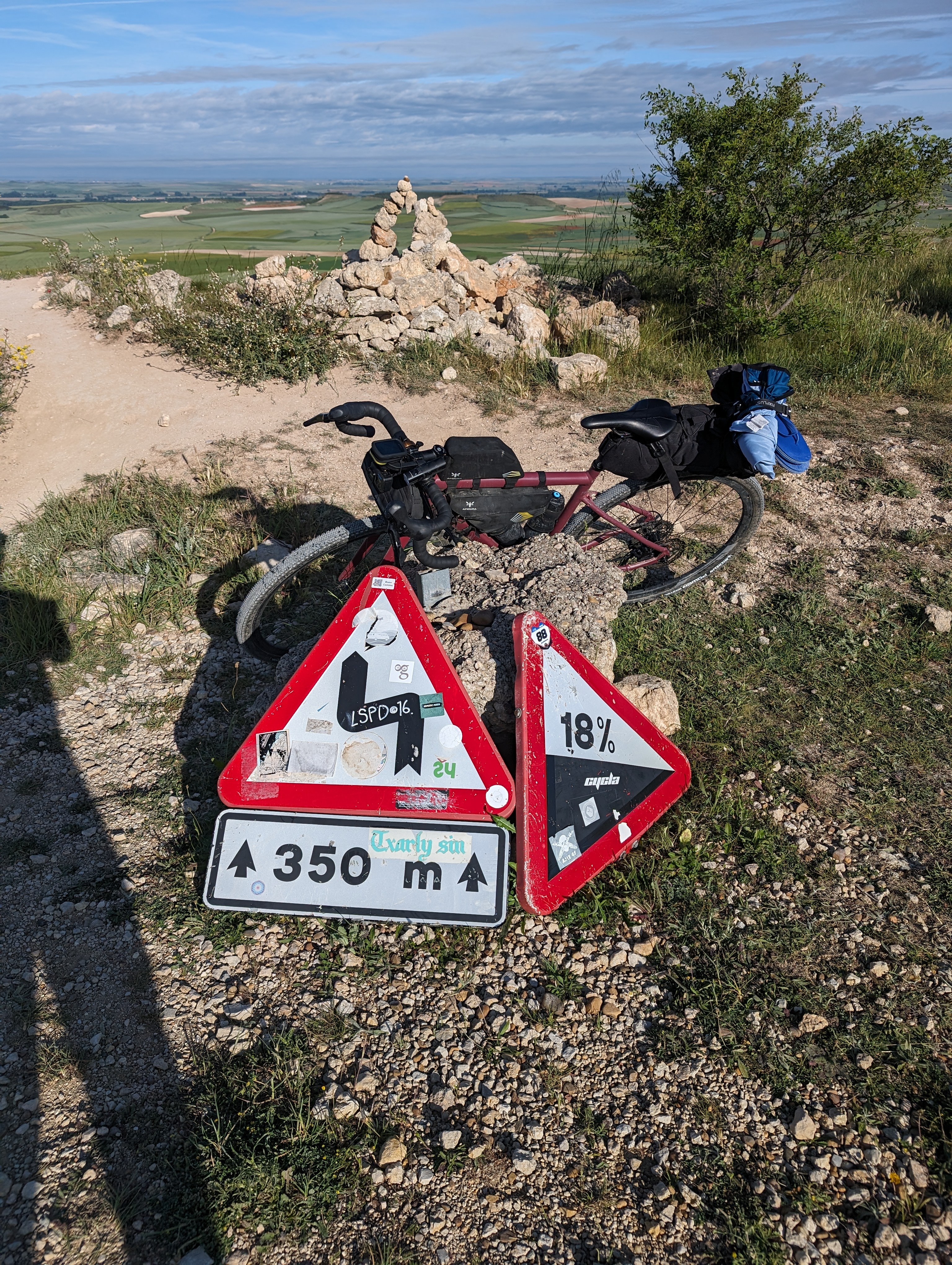
Descent from the Alto de Mostelares
Now, we are in the heart of the Castilian Meseta. In the next kilometers (not only today but also tomorrow), there will be little elevation gain.
In no time, I passed by the San Nicolás hospital, another albergue in its most primitive sense. Who knows, maybe I’ll spend a night there on a future journey…
Just a few meters further, I reached the Puente Fitero, which crosses the Pisuerga river and leads to the province of Palencia.
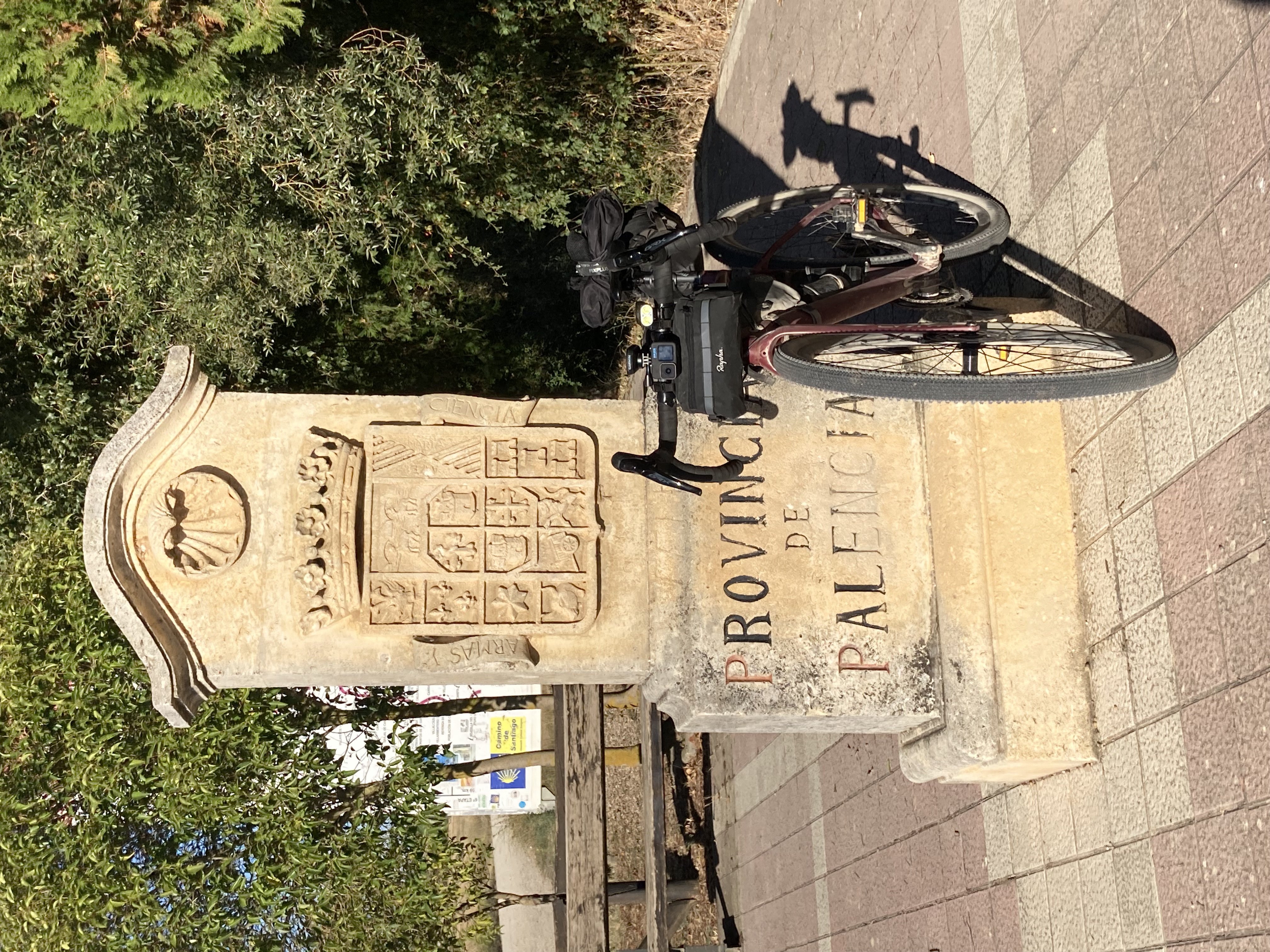
Province of Palencia
The bridge dates back to the 11th century, even older than the San Nicolás hermitage, whose construction dates back to the 12th century.
After crossing the bridge, I took a detour to the right toward Itero de la Vega, and after another 8 or 9 kilometers, I reached Boadilla del Camino, where I stopped at its spectacular Gothic justice roll.
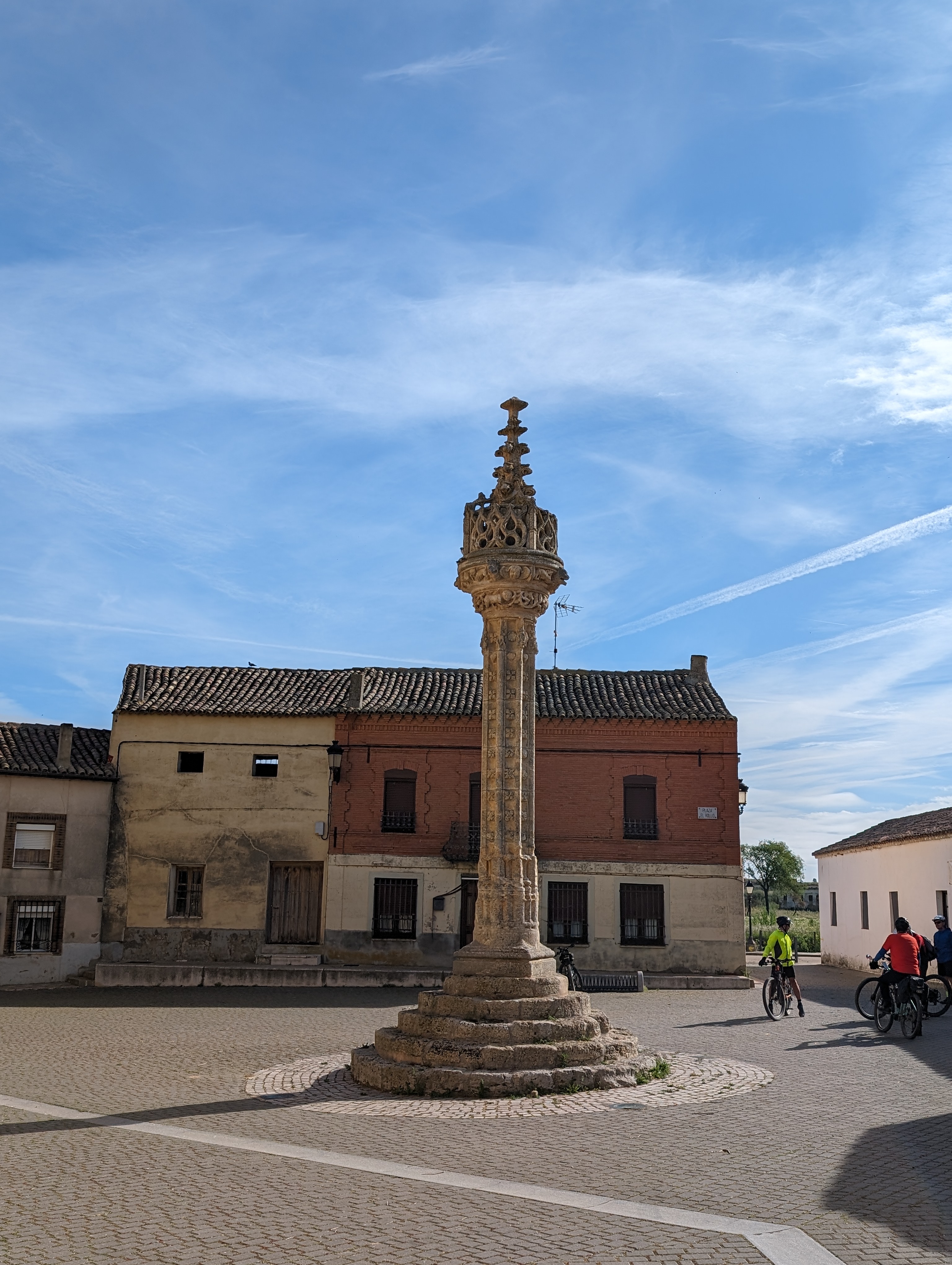
Justice roll in Boadilla del Camino
Near the roll, I met the group of e-bikers again, very friendly guys from Cartagena (Murcia, Spain) with whom I would continue to meet frequently during the morning.
At the exit of Boadilla, I start one of my favorite sections of the Camino, the one that runs alongside the Canal de Castilla. Due to some construction works, a small detour was necessary, but soon I was back on its bank.
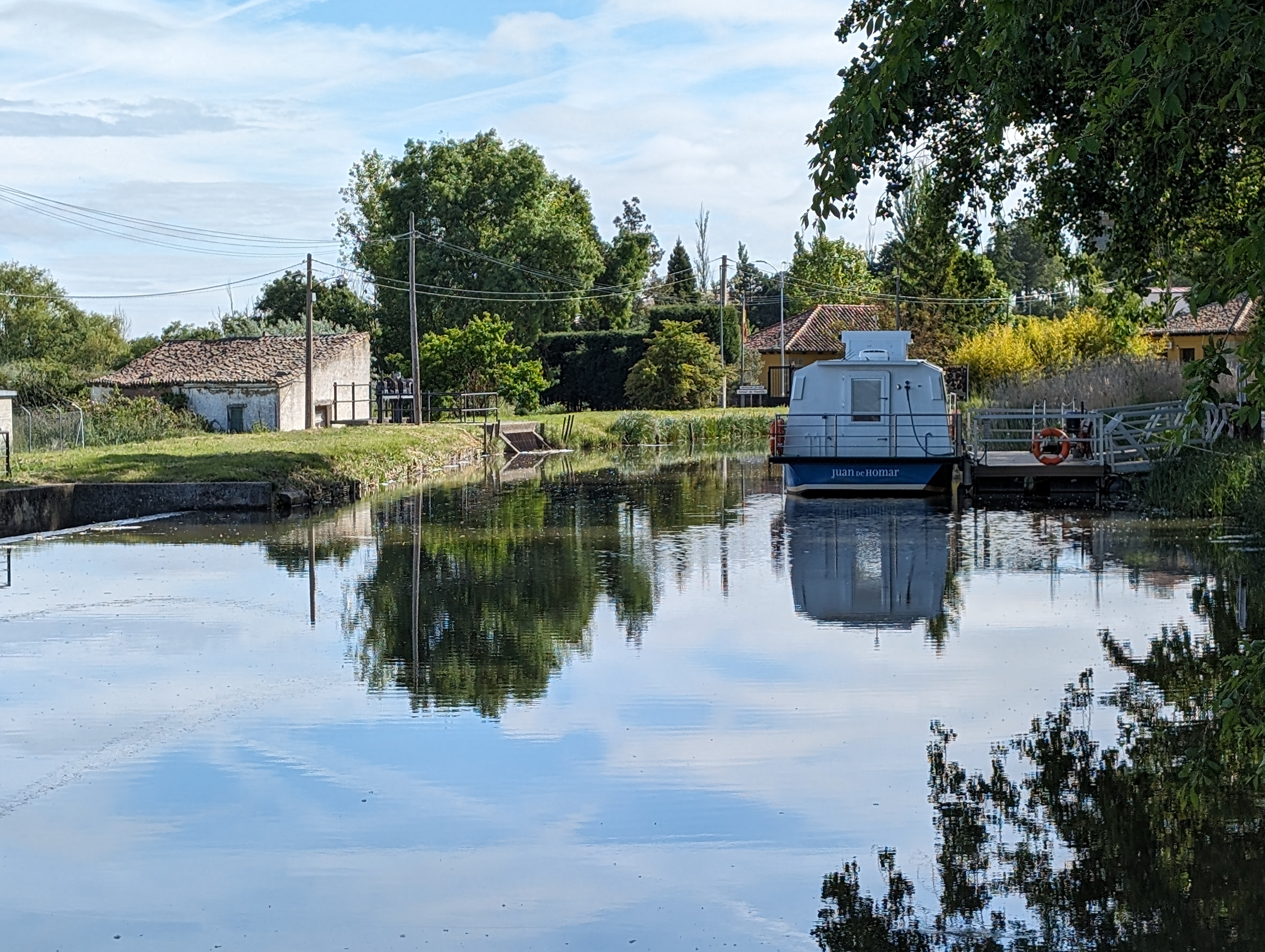
Boat on the Canal de Castilla
The spectacular quadruple lock indicated the proximity of Frómista, where I stopped for the usual pincho de tortilla next to San Martín de Tours. At the table next to mine sat the friendly Cartagena group. I said goodmye and did not see them again.
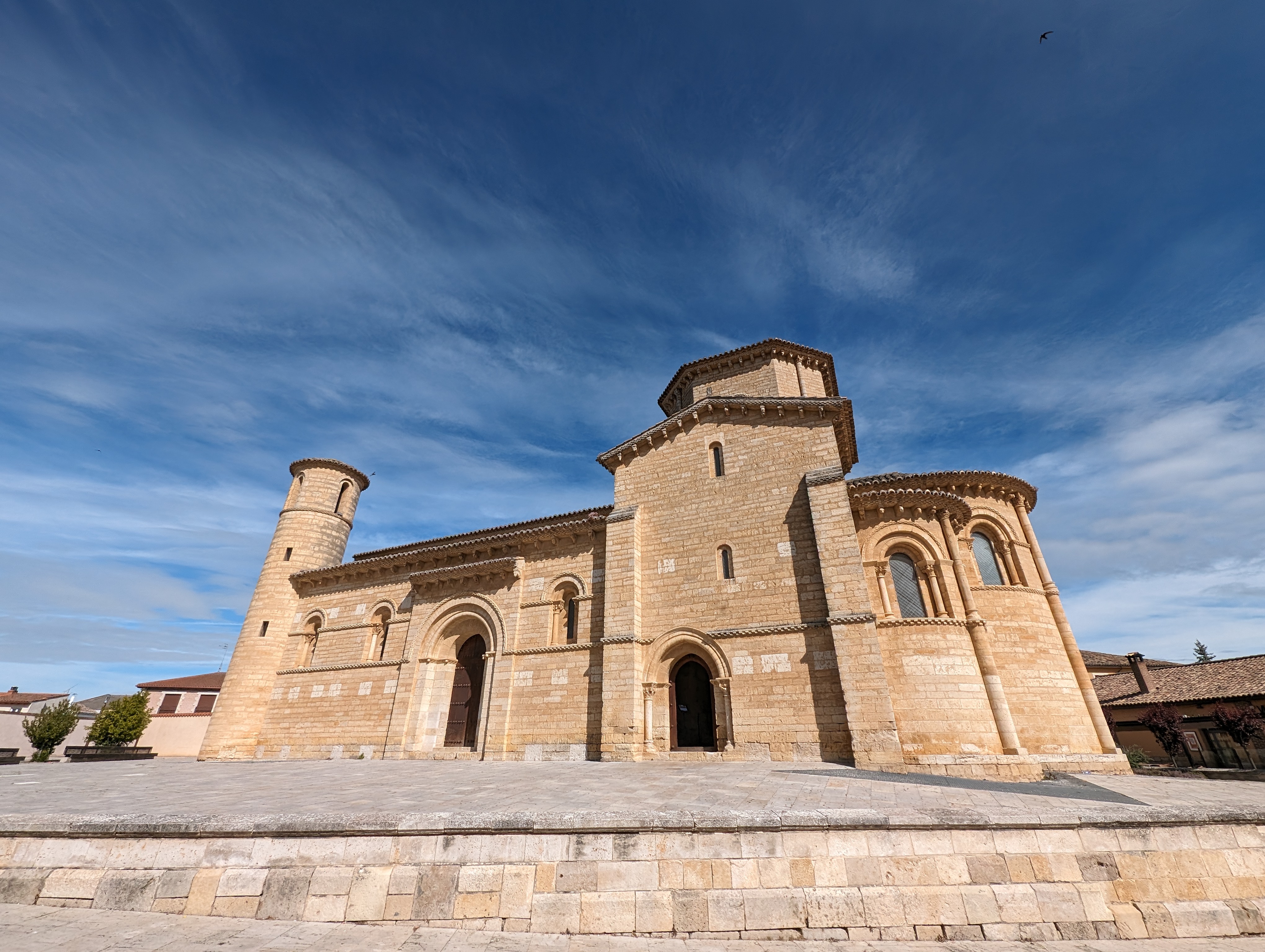
San Martín de Tours
I didn’t linger too much and continued the journey through Tierra de Campos in Palencia, crossing Población de Campos, Revenga de Campos, Villarmentero de Campos, and Villalcázar de Sirga until I reached the next stop: Carrión de los Condes. In a burst of gastronomic imagination, I had another pincho de tortilla with Coca-Cola; that and the Haribos, now that I was hungry again, were the foundation of my diet on the Camino 😂 By the way, I had stopped taking the new gels, so I was almost sure they were to blame for my eating problems in the first two days.
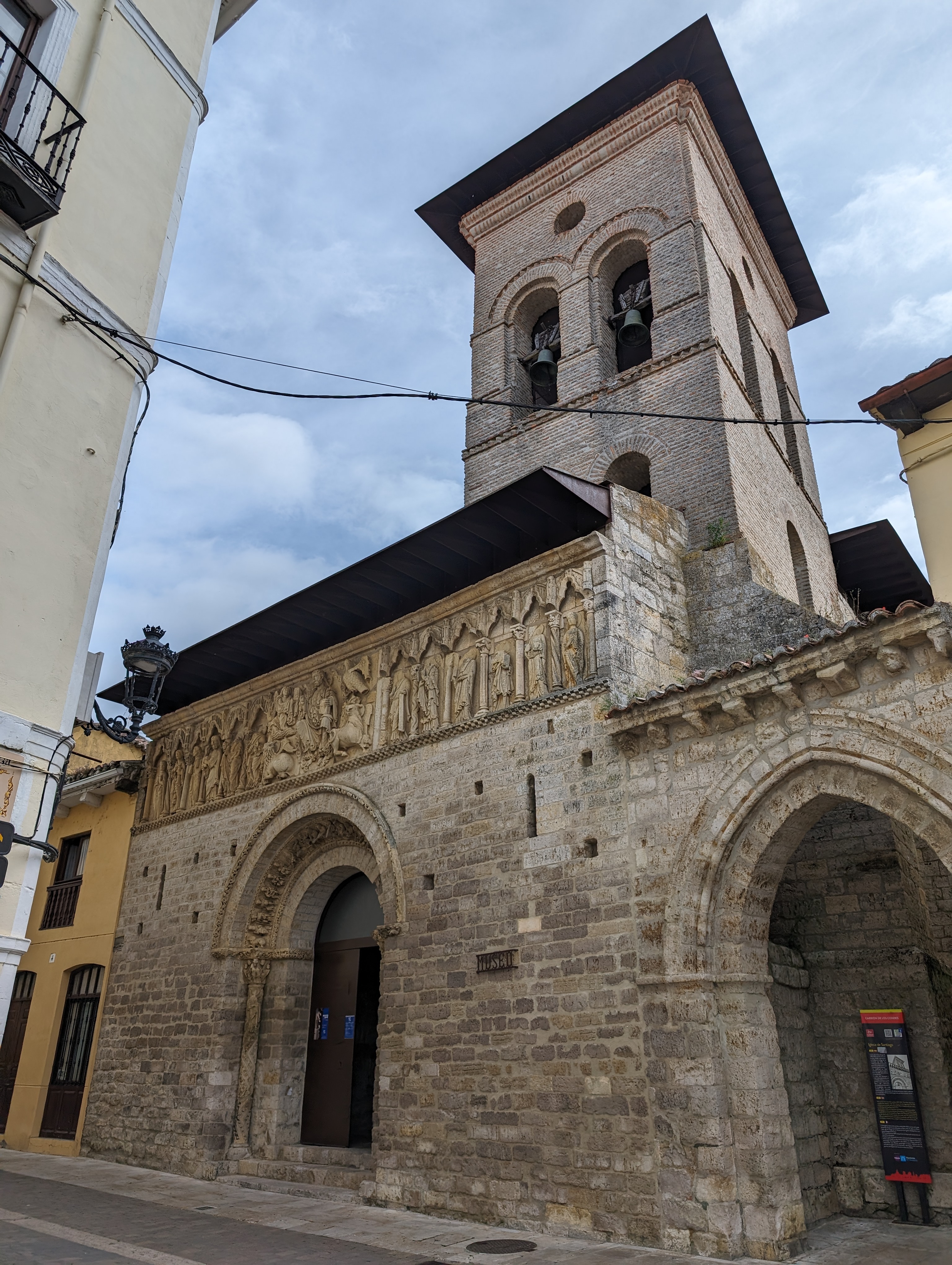
Carrión de los Condes: Santiago Church
I left Carrión by San Zoilo, making sure to fill the bottles as the longest stretch of the Camino Francés without towns was coming: the next village, Calzadilla de la Cueza, was about 16 kilometers away. On a bike, it’s not a problem but for walking pilgrims it is a remarkable distance. However, there is usually one of those mobile bars halfway.
I think it was on this stretch that I saw a banner that read “Sin Meseta no hay Camino” (Without the Meseta, there is no Camino). And it seems very common for pilgrims to start from Roncesvalles or Saint Jean Pied de Port to Burgos and then take a bus to León, avoiding much of the wonderful Castilian Meseta.
Obviously I am not one to judge, but I really don’t understand that approach. Some say that the Meseta is where the spirit of the Camino is most intensely felt and, in my limited experience, I think that might be true. It’s also true that I have never crossed it on foot, which is undoubtedly much harder than by bike. But even so, it doesn’t make sense to me; I try to put myself in that situation and think I would feel like I’m “cheating,” like I’m not truly doing the Camino de Santiago.
With this thoughts in my head, I arrived in Calzadilla de la Cueza. I continued on the trail to Ledigos, where I saw the last walking pilgrims calling it a day. I still had quite a few kilometers ahead (in the end, it would be almost 40!) as I hadn’t yet decided where or when to stop.
After Ledigos, I crossed Terradillos de los Templarios, Moratinos (with its cellars that look like small hobbit houses), and San Nicolás del Real Camino, the last Palencian town on the Camino Francés. A few minutes after crossing it, I entered the province of León, the third of the day after Burgos and Palencia.
Arriving in Sahagún, there is a small detour that I didn’t hesitate to take, which led me to the hermitage of Virgen del Puente, an old hospital and leprosarium. The small Romanesque-Mudejar building is next to the Valderaduey River; next to it are statues of Alfonso VI and Bernardo de Sedirac that mark the geographical center of the Camino as they are equidistant from Roncesvalles and Santiago de Compostela.
Once in Sahagún, I took a walk around its Plaza Mayor. I sat for a while in front of the restaurant Luis, remembering savoring the specialty of the Leonese town in 2022: leeks!
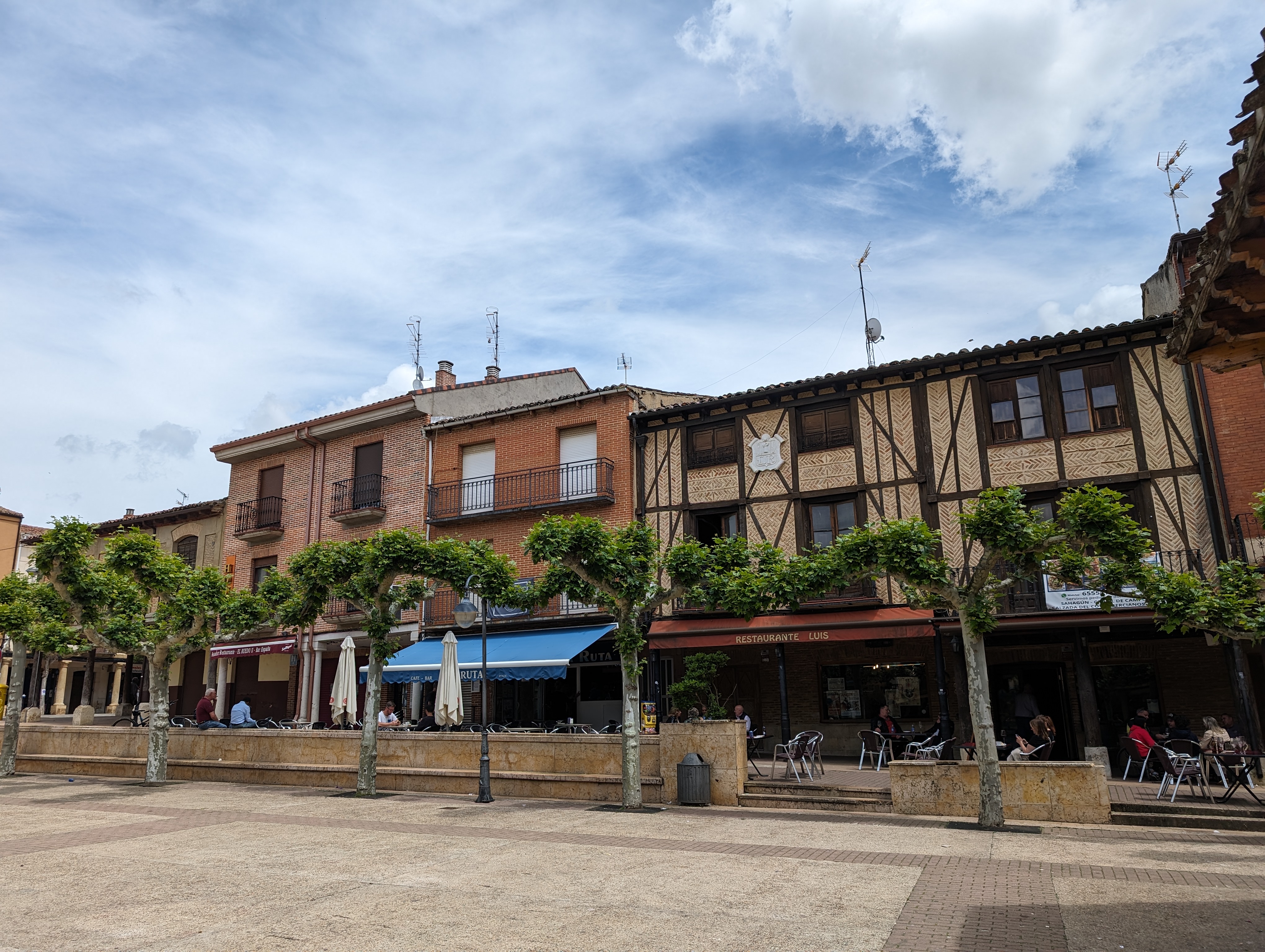
Plaza Mayor of Sahagún
However, staying in Sahagún would mean repeating an stage from 2022 for the third day in a row, something I didn’t want to do. So, I decided to continue at least to the next village, not without first recharging my batteries with some delicious pinchos:
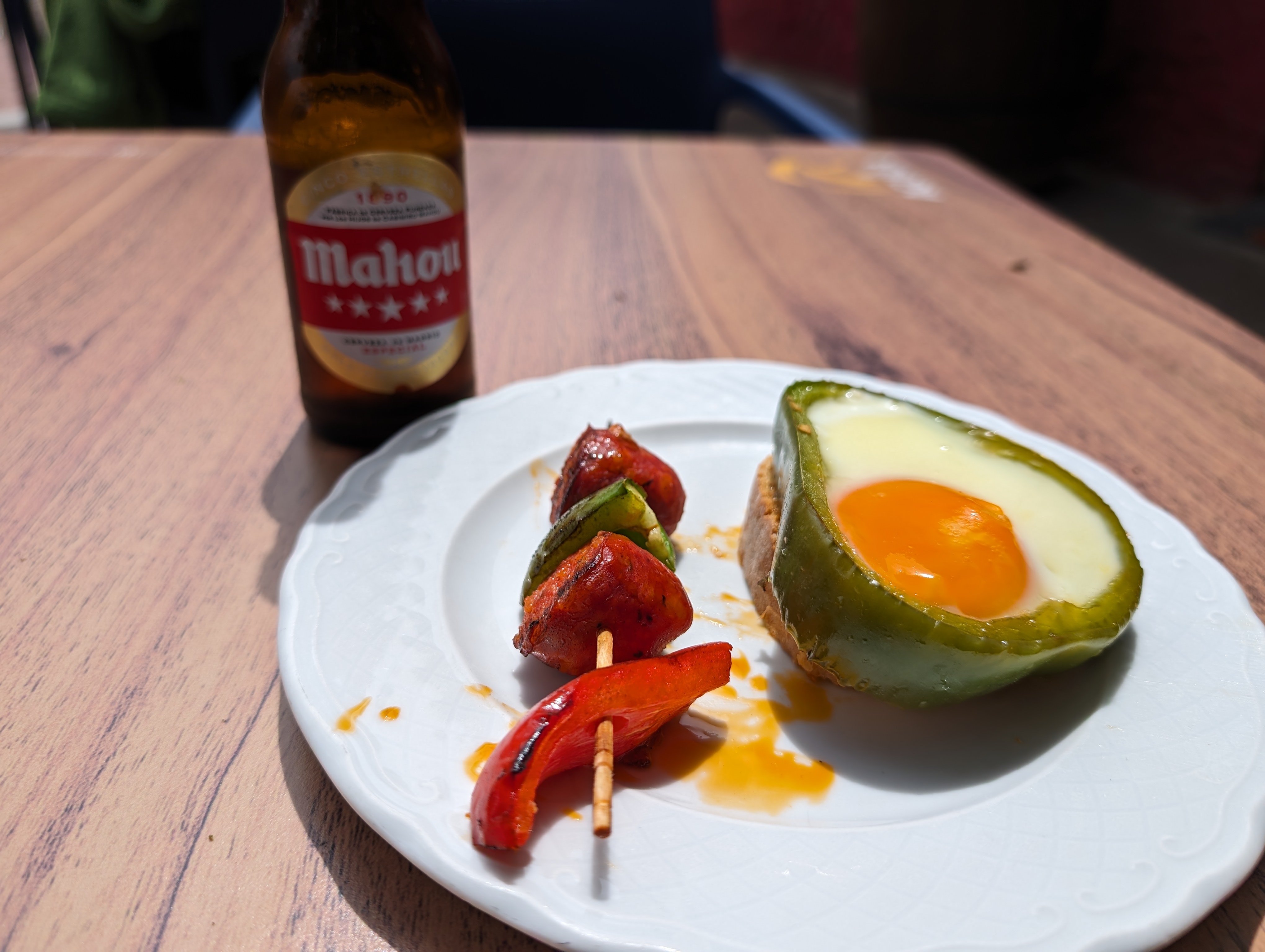
Pinchos in Sahagún
I crossed the Cea River (taking a small detour along the marked alternative, as the Puente Canto was under construction) and continued to Bercianos del Real Camino. Suddenly, I heard a familiar sound approaching from behind: it was a group of Colombian bicigrinos riding at full speed behind me. I tried to catch up and strike up a conversation, but they were going very fast; it was strange because I had overtaken them when leaving Carrión, but they told me they went like this: slow at times and very fast at others.
Still riding in that group, I passed the arch that also marks the halfway point of the Camino Francés, near Bercianos. There I left the group as I passed the first albergue: La Perala. It was new and very large, so I expected to find a place; but to my surprise, it was fully booked.
So I continued to Bercianos where I also found no accommodation, so I headed to El Burgo Ranero. I remembered the exquisite tomato toast I had for breakfast in 2022 in that town. Once there, I made a couple of calls and found everything occupied!
The next options were Reliegos and Mansilla de las Mulas; but before continuing, I came across the municipal albergue Domenico Laffi. I inquired and there were still a free bunk bed, so I settled in there.
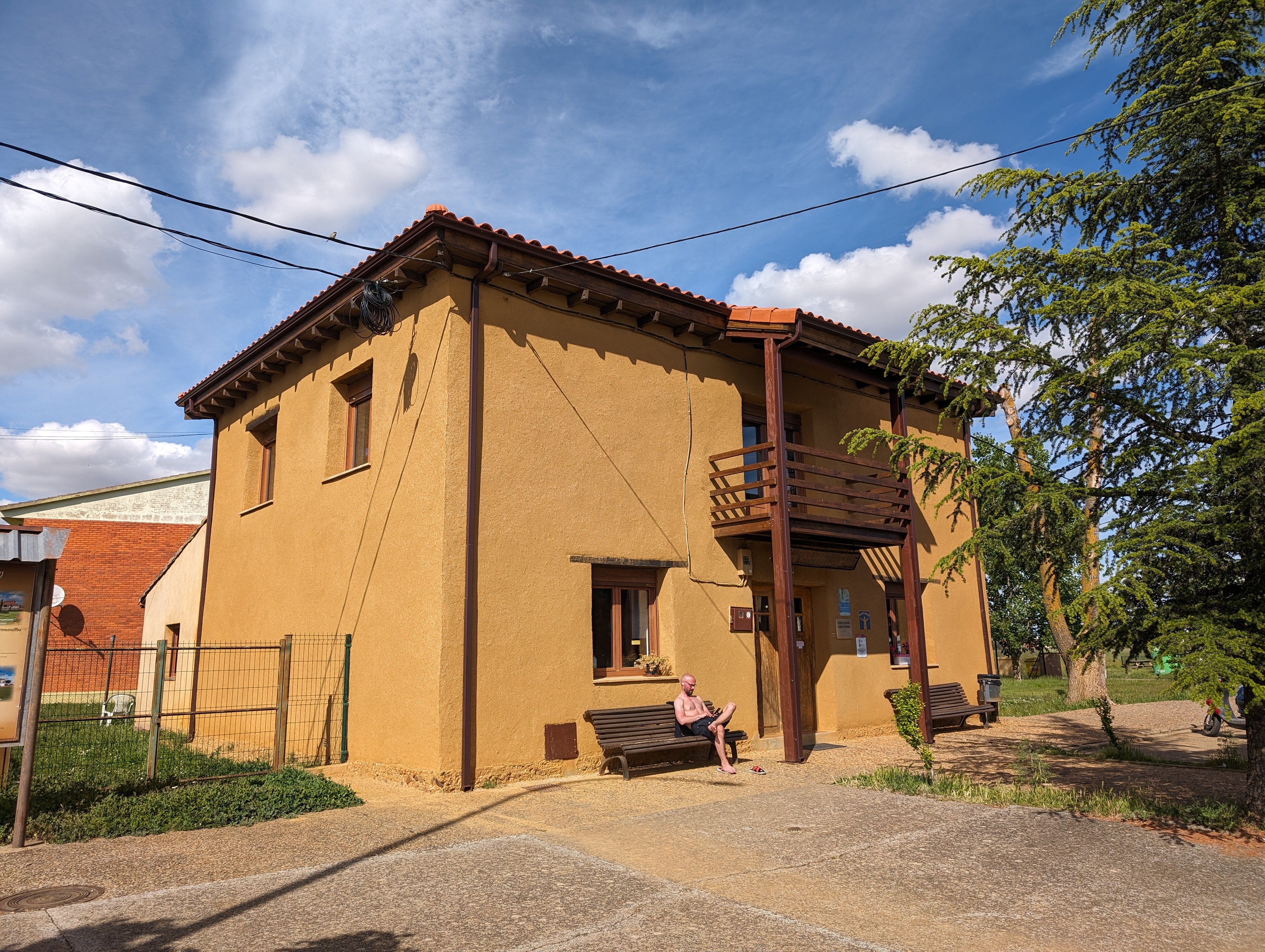
Municipal Hostel in El Burgo Ranero
It is a donation albergue (“pay what you will”) and the hospitaleros on duty, Angela and Stephen, were an elderly Australian couple. They had a cool map keeping track of the various nationalities of the guests; I was the first Spaniard to arrive today, so there were already seven different countries represented.
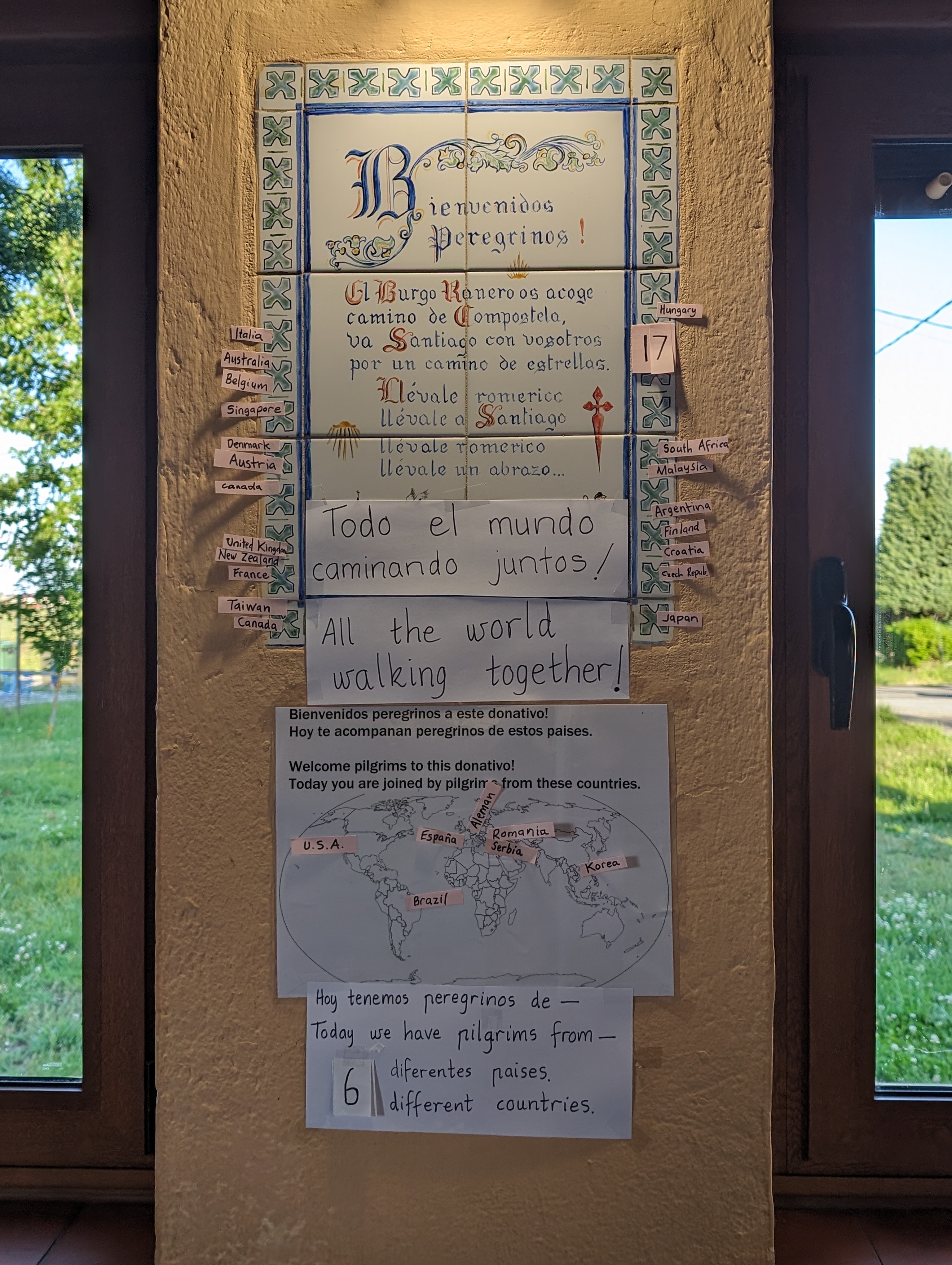
7 nations
First of all, I took a shower, hand-washed (there was no washing machine) some clothes, and went to the village store to buy some food for dinner and breakfast.
The atmosphere in this type of albergue is nothing like the “private” ones. There is a kitchen where you can take what you need (and leave what you don’t). Those who cook share their food, and those who don’t, like me, take care of washing the dishes. Everyone collaborates in one way or another.
The truth is it was one of the most pleasant afternoons and evenings, sharing long conversations with other pilgrims. Once again, my friend Luis was present when I explained to Angela and Stephen what I was doing there, why I was doing the Camino. Marcelo, a Brazilian pilgrim traveling with his wife and young son, shared wine; Eliza, a German pilgrim, recounted the different experience of doing the Camino as a couple after having done it alone a few years earlier; I offered bananas I had brought from the store. And so it went until bedtime…

The wine Marcelo shared
The room, full of bunk beds, was covered by a very high ceiling that looked like the hayloft in the movies. It was cold, and I only had the sleeping bag liner, so I had to wear my down jacket to feel comfortable; nevertheless, I slept soundly and woke up really rested.
Stage Summary
- Distance: 117 kilometers
- Elevation Gain: 700+ meters
- Time: About 9 hours, including stops
Track
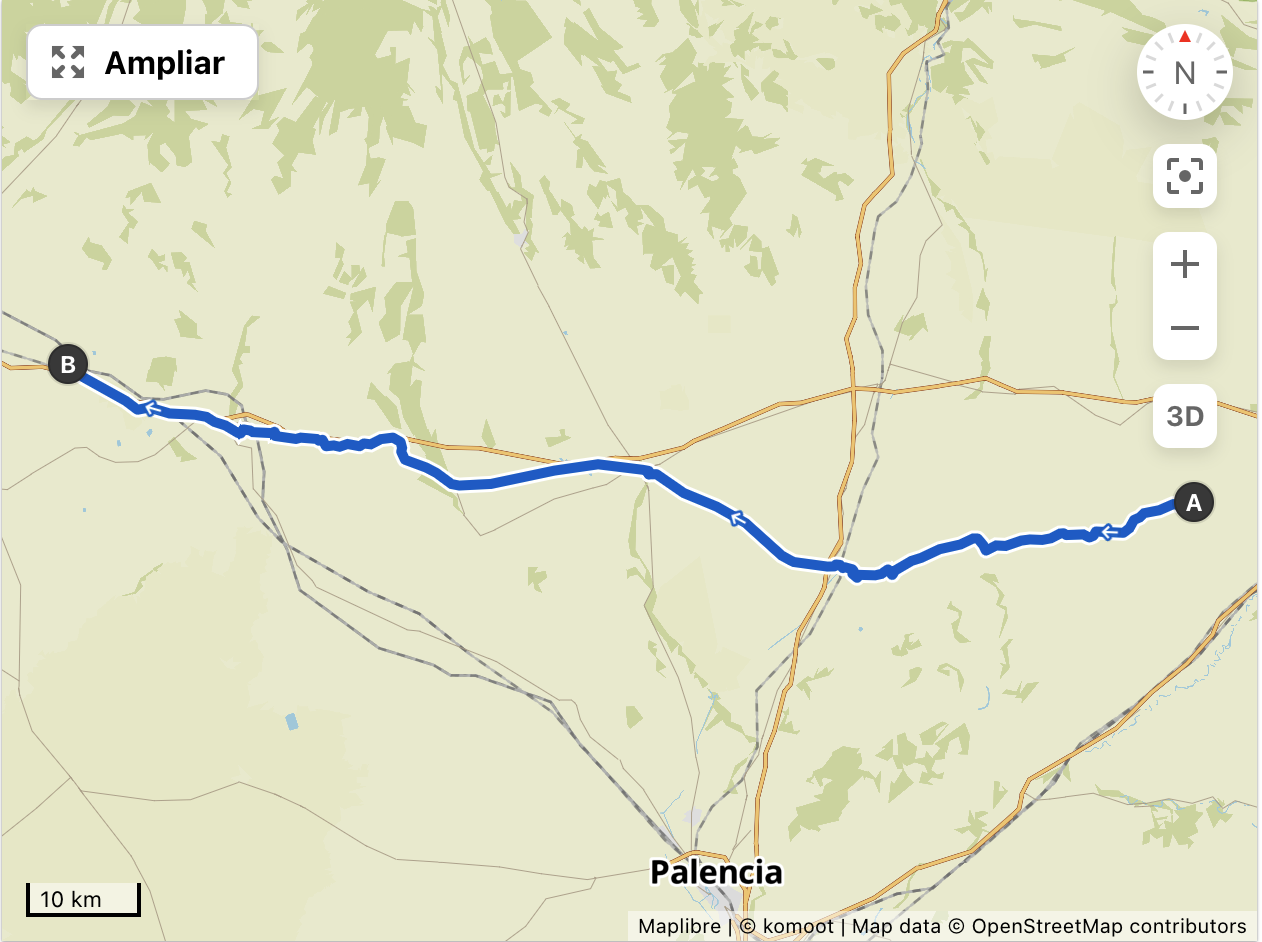
Profile

👈 Day 2: from Grañón to Fuente Sidres | Day 4: from El Burgo Ranero to El Ganso 👉